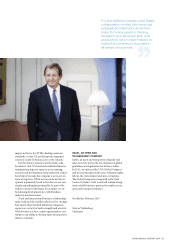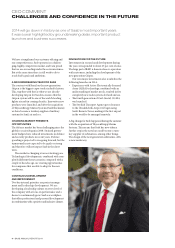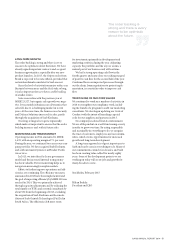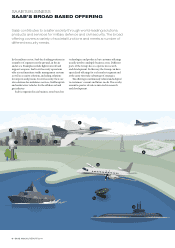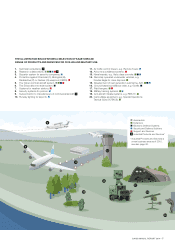Saab 2014 Annual Report Download - page 17
Download and view the complete annual report
Please find page 17 of the 2014 Saab annual report below. You can navigate through the pages in the report by either clicking on the pages listed below, or by using the keyword search tool below to find specific information within the annual report.
EUROPE, MIDDLE EAST & AFRICA
Europe is Saab’s largest market outside the Nordic countries. Defence
spending has decreased in recent years, mainly due to the economic
slowdown. Although a turnaround is expected within a few years.
Most countries in the region are downsizing their defence organi-
sations, in order to aord to modernise their equipment. Russia is
going against the grain and raising its defence spending in local
currency. Saab does not sell defence materiel to Russia.
In the EU, there are growing demands for secure ows of goods
and people and the protection of shiing borders. Multinational
collaborations between defence industries are considered necessary
to develop future high-tech defence solutions.
Defence spending in the Middle East rose by 7.8 per cent in 2014.
Growth is expected to continue in coming years, but at a slower rate.
Further progress was made during the year, mainly in surveillance,
training and naval solutions.
Africa south of the Sahara accounts for an estimated 1.0 per cent
of global defence spending. Budgets rose by 3.7 per cent in 2014, and
growth is expected to remain strong for years to come.
Saab’s operations in the region are concentrated in South Africa,
with smaller operations in a number of other countries. For example,
South Africa operates 26 Gripen. e market outlook is positive,
especially in the security sector, including the police, coast guard
and oil and gas industry.
Order and sales trend
Saab’s strong position in training and simulation, primarily in the
UK, was consolidated through extended support contracts for several
military training centres. Radar still accounts for a signicant share
of the Group’s sales in the UK. Saab also received a major order for
new versions of the AT4 support weapon system from the French
Armed Forces.
In Central and Eastern Europe, demand for Gripen remained
strong among current users. e extended lease between Czech
Republic and Sweden was an important milestone. Slovakia, the
Czech Republic and Sweden signed a declaration of intent on joint
airspace surveillance of Slovakia and Czech Republic that will pave
the way for Gripen to become part of the Slovakian Air Force.
NORDIC & BALTIC
Nordic & Baltic is Saab’s largest market. In addition to the Nordic
and Baltic countries, the market area includes Poland. e Swedish
Armed Forces are an important reference for many international
projects as well. Good relations with Swedish decision makers, civilian
and military customers and authorities are critical to the business.
Defence spending in the region is declining. In 2014, the decrease
was 4.1 per cent. However, forecasts point to increased defence bud-
gets within a few years. Finland has appointed a working group for
the procurement of new ghter jets and Norway is preparing to buy
new submarines. e radar area also oers opportunities in coming
years. e Baltic countries have to modernise some of their equip-
ment, but have limited budgets. e market for civil security is
growing in the region.
e acquisition of the Swedish shipyard yssenKrupp Marine
Systems was nalised during the second quarter and strengthens
Saab’s position as a comprehensive supplier of naval systems.
Order and sales trend
During the year, FMV ordered equipment, support and maintenance
systems for Gripen E valued at approximately SEK 5.8 billion for the
period 2013–2026. In Finland, the co-operation with the Finnish
Armed Forces resulted in an order for military training systems. Saab
also received an order from the Finnish military vehicle manufacturer
Patria Land Systems Oy for electronics for the Patria AMV 8x8
vehicles being supplied to South Africa.
In 2014, Saab signed a letter of intent with FMV covering the Swedish
Armed Forces’ underwater capabilities for the period 2015–2024 and
potential orders of approximately SEK 11.2 billion.
Saab also received an order from the South Korean shipyard
Daewoo Shipbuilding & Marine Engineering relating to healthcare
capabilities aboard a Norwegian Navy support vessel. e Norwegian
Army placed an order for the development and manufacture of the
next generation of vehicle simulators.
In addition, a ve-year framework agreement was signed with
Estonia, Latvia, Lithuania, Czech Republic and Poland to provide
ammunition for the Carl-Gustaf weapon system.
12,330
Number of employees in the market area
1%
Share of global defence materiel spending
2016 – 2020
2%
Average annual growth 2016 – 2020
1,355
Number of employees in the market area
27%
Share of global defence materiel spending
2016 – 2020
2%
Average annual growth 2016 – 2020
MARKET
MARKET AREAS
The Group’s market organisation is divided into five geographical market areas and is based
on a strong local presence in a number of key markets. A reorganisation was implemented
as of 2015 to adapt to changes in the market. Saab’s market areas are now Nordic & Baltic,
Europe, Middle East & Africa, North America, Latin America and Asia Pacific.
SAAB ANNUAL REPORT 2014 – 13


